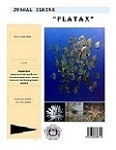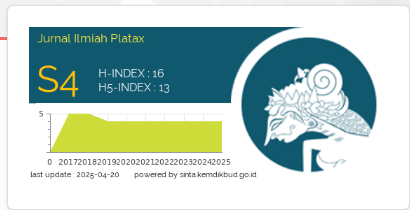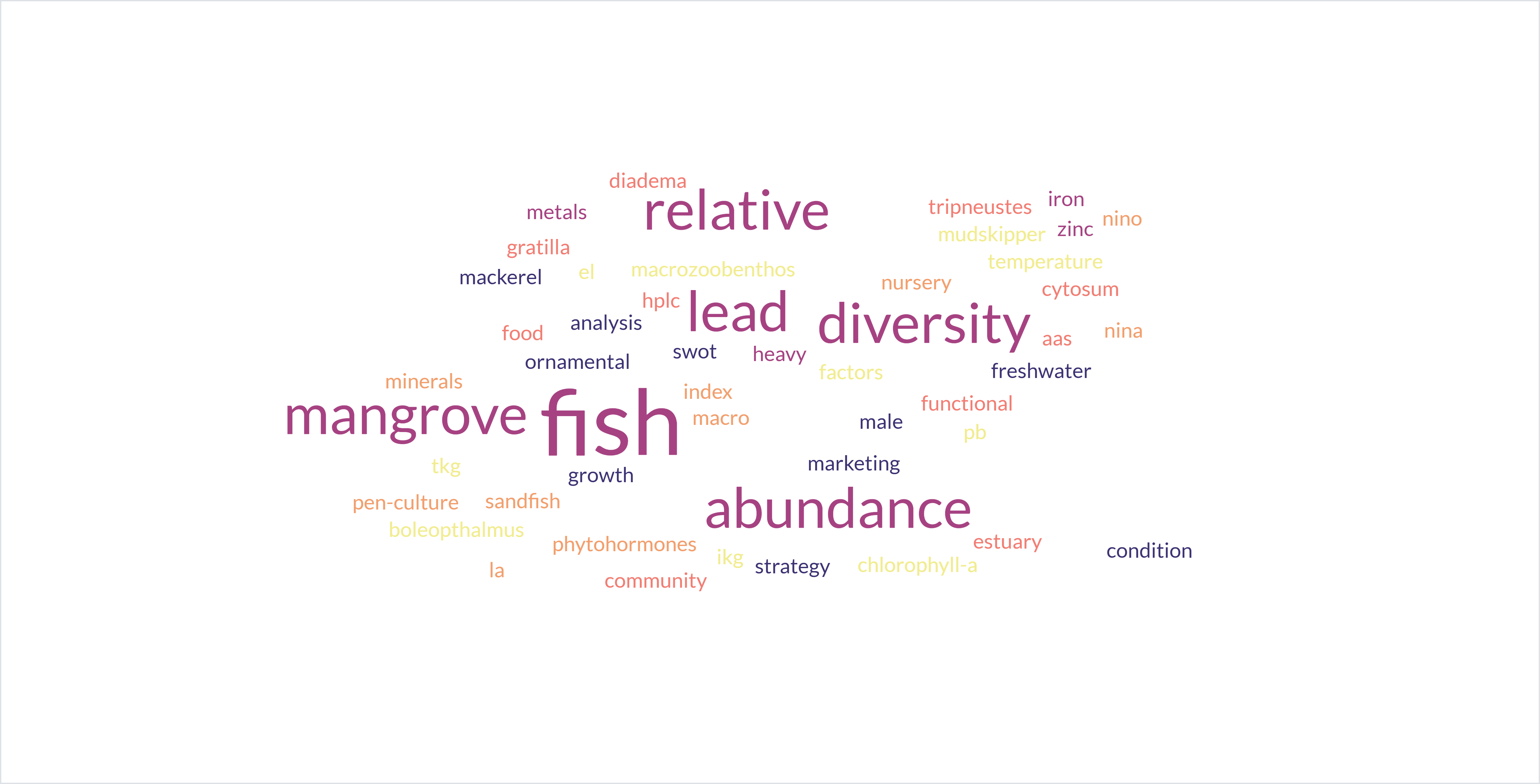Qualitative Phytochemical Analysis of Gracilaria verrucosa from North Sulawesi Waters
DOI:
https://doi.org/10.35800/jip.v11i2.48777Keywords:
Phytochemical content;, Gracilaria verrucosa;, secondary metabolites;Abstract
The research aims to determine the phytochemical content such as phenolics, flavonoids, tannins, saponins, alkaloids, steroids, and triterpenoids found in the seaweed G. verrucosa. Seaweed G. verrucosa taken from the waters of North Sulawesi, Nain Village, North Minahasa, was extracted by maceration for 24 hours at room temperature, repeated 3 times using 96% ethanol solvent. The analysis in this study consisted of seven test parameters such as phenolic compounds, flavonoids, tannins, saponins, steroids, triterpenoids, and alkaloids. The results of the analysis showed that the secondary metabolites of G. verrucosa contained phytochemical compounds such as phenols, flavonoids, tannins, saponins, steroids, and alkaloids, and no triterpenoid compounds were found. It was concluded that G. verrucosa which grows in the waters of North Sulawesi, Nain Village, can function as functional food, and medicine because it has natural bioactive compounds.
Keywords: Phytochemical content, Gracilaria verrucosa, secondary metabolites
Abstrak
Penelitian bertujuan mengetahui kandungan fitokimia seperti fenol, flavanoid, tanin, saponin, alkaloid, steroid, dan triterpenoid yang terdapat pada rumput laut G. verrucosa. Senyawa metabolit sekunder yang umum terdapat pada tanaman adalah senyawa terpenoid, alkaloid, fenolik, streroid, saponin, tannin. Rumput laut G. verrucosa yang di ambil dari perairan Sulawesi Utara Desa Nain Minahasa Utara di ekstraksi dengan cara maserasi selama 24 jam pada suhu ruang di ulangi sebanyak 3 kali menggunakan pelarut etanol 96 %. Analisis pada penelitian ini terdiri dari tujuh parameter pengujian seperti senyawa fenol, flavonoid, tanin, saponin, steroid, triterpenoid dan alkaloid. Hasil analisis menunjukan bahwa kandungan metabolit sekunder dari G. verrucosa mengandung senyawa fitokimia seperti fenol, flavonoid, tanin, saponin, steroid, alkaloid dan tidak ditemukan adanya senyawa triterpenoid. Hal ini disimpulkan bahwa G. verrucosa yang tumbuh di perairan Sulawesi utara Desa Nain dapat berfungsi sebagai pangan fungsional, obat-obatan karena memiliki senyawa bioaktif alami.
Kata kunci: Kandungan fitokimia, Gracilaria verrucosa, metabolit sekunder
References
Anggadiredja, J. T. (2011). Laporan forum rumput laut. Pusat Riset Pengolahan Produk Dan Sosial Ekonomi Kelautan Dan Perikanan. Jakarta.
Arsianti, A., Bahtiar, A., Wangsaputra, V. K., Azizah, N. N., Fachri, W., Nadapdap, L. D., Fajrin, A. M., Tanimoto, H., & Kakiuchi, K. (2020). Phytochemical composition and evaluation of marine algal Sargassum polycystum for antioxidant activity and in vitro cytotoxicity on hela cells. Pharmacognosy Journal, 12(1).
Arukwe, U., Amadi, B. A., Duru, M. K. C., & Agomuo, E. N. (2012). Chemical Composition of Persea Americana leaf, fruit and seed. Ijrras, 11(2), 346–349.
Arukwe, U., Amadi, B. A., Duru, M. K. C., Agomuo, E. N., Adindu, E. A., Odika, P. C., Lele, K. C., Egejuru, L., & Anudike, J. (2012). Chemical composition of Persea americana leaf, fruit and seed. Ijrras, 11(2), 346–349.
Bintoro, A., Ibrahim, A. M., Situmeang, B., Kimia, J., & Cilegon, B. (2017). Analisis dan identifikasi senyawa saponin dari daun bidara (Zhizipus mauritania L.). Jurnal Itekima, 2(1), 84–94.
Boopathy, N. S., & Kathiresan, K. (2010). Anticancer drugs from marine flora: an overview. Journal of Oncology, 2010, 1–18.
Croteau R, Kutchan TM & Lewis NG. 2015. Natural products (Secondary metabolites). In Biochemistry & Molecular Biology of Plants, B. Buchanan, W. Gruissem, R. Jones, Eds. 2nd Ed. London: Wiley & Blackwell.
Chakraborty, N., Ghosh, R., Ghosh, S., Narula, K., Tayal, R., Datta, A., & Chakraborty, S. (2013). Reduction of oxalate levels in tomato fruit and consequent metabolic remodeling following overexpression of a fungal oxalate decarboxylase. Plant Physiology, 162(1), 364–378.
Danapalan, R., & Thangaraju, N. (2013). Phytochemical Screening And Comparative Analysis of AntimicrobialActivity Of Selected Species Of Brown Seaweeds From Gulf Of Mannar, Tamil Nadu, India. Journal Of Modern Biotechnology, 4, 1–7.
Desmiaty, Y., Ratih, H., Dewi, M. A., & Agustín, R. (2008). Penentuan jumlah tanin total pada daun jati belanda (Guazuma ulmifolia Lamk) dan daun sambang darah (Excoecaria bicolor Hassk.) secara kolorimetri dengan pereaksi biru prusia. Ortocarpus, 8(1), 106–109.
Dhurhania, C. E., & Novianto, A. (2018). Uji kandungan fenolik total dan pengaruhnya terhadap aktivitas antioksidan dari berbagai bentuk sediaan sarang semut (Myrmecodia pendens). Jurnal Farmasi Dan Ilmu Kefarmasian Indonesia, 5(2), 62–68.
Domettila, C., Joselin, J., & Jeeva, S. (2013). Phytochemical analysis on some south Indian seaweeds. Journal of Chemical and Pharmaceutical Research, 5(4), 275–278.
Dotulong, V., Montolalu, L., & Damongilala, L. J. (2016). Potensi Anti Bakteri Rumput Laut Merah Laurencia sp. Asal Perairan Sulawesi Utara. Jurnal, Bioteknologi Kelautan Dan Perikanan.
Eluvakkal, T., Sivakumar, S. R., & Arunkumar, K. (2010). Fucoidan in some Indian brown seaweeds found along the coast Gulf of Mannar. International Journal of Botany, 6(2), 176–181.
Endarini, L. H. (2016). Farmakologis dan Fitokimia. Modul Bahan Ajar Cetak. Pusdik SDM Kesehatan. Kementrian Kesehatan Republik Indonesia.
Ergina, E., Nuryanti, S., & Pursitasari, I. D. (2014). Uji kualitatif senyawa metabolit sekunder pada daun palado (Agave angustifolia) yang diekstraksi dengan pelarut air dan etanol. Jurnal Akademika Kimia, 3(3), 165–172.
Febrianto, W., Djunaedi, A., Suryono, S., Santosa, G. W., & Sunaryo, S. (2019). Potensi Antioksidan Rumput Laut Gracilaria verrucosa Dari Pantai Gunung Kidul, Yogyakarta. Jurnal Kelautan Tropis, 22(1), 81.
Fitri, W. E., & Putra, A. (2021). Peranan Senyawa Flavonoid Dalam Meningkatkan Sistem Imun Di Masa Pandemi Covid-19. Prosiding Seminar Nasional Stikes Syedza Saintika, 1(1).
Ghufran, M. (2010). Kiat Sukses Budidaya Rumput Laut di Laut dan Tambak. Yogyakarta. Lily Publisher.
Gutzeit, H. O., & Ludwig-Müller, J. (2014). Plant natural products: synthesis, biological functions and practical applications. John Wiley & Sons.
Herborne, J. B. (1973). Phytochemical methods. A Guide to Modern Techniques of Plant Analysis, 2, 5–11.
Jati, B. N., Nuraeni, C., Yunilawati, R., & Oktarina, E. (2019). Phytochemical screening and total lipid content of marine macroalgae from Binuangeun beach. Journal of Physics: Conference Series, 1317(1), 12103.
Kasim, M. (2016). Makro alga. Penebar Swadaya. Jakarta, 116.
Lantah, P. L., Montolalu, L. A., & Reo, A. R. (2017). Kandungan Fitokimia Dan Aktivitas Antioksidan Ekstrak Metanol Rumput Laut Kappaphycus alvarezii. Media Teknologi Hasil Perikanan, 5(3), 73.
Martin-Creuzburg, D., & Merkel, P. (2016). Sterols of freshwater microalgae: potential implications for zooplankton nutrition. Journal of Plankton Research, 38(4), 865–877.
Mehdinezhad, N., Ghannadi, A., & Yegdaneh, A. (2016). Phytochemical and biological evaluation of some Sargassum species from Persian Gulf. Research in Pharmaceutical Sciences, 11(3), 243.
Mouritsen, O. G., Bagatolli, L. A., Duelund, L., Garvik, O., Ipsen, J. H., & Simonsen, A. C. (2017). Effects of seaweed sterols fucosterol and desmosterol on lipid membranes. Chemistry and Physics of Lipids, 205, 1–10.
Ndhlala, A. R., Kasiyamhuru, A., Mupure, C., Chitindingu, K., Benhura, M. A., & Muchuweti, M. (2007). Phenolic composition of Flacourtia indica, Opuntia megacantha and Sclerocarya birrea. Food Chemistry, 103(1), 82–87.
Ningrum, R., Purwanti, E., & Sukarsono, S. (2016). Alkaloid compound identification of Rhodomyrtus tomentosa stem as biology instructional material for senior high school X grade. JPBI (Jurnal Pendidikan Biologi Indonesia), 2(3), 231–236.
Nofiani, R. (2008). Urgensi dan mekanisme biosintesis metabolit sekunder mikroba laut. Jurnal Natur Indonesia, 10(2), 120–125.
Nugroho, E., & Kusnendar, E. (2015). Agribisnis rumput laut. Penebar Swadaya Grup.
Oh, J.-H., Kim, J., & Lee, Y. (2016). Anti-inflammatory and anti-diabetic effects of brown seaweeds in high-fat diet-induced obese mice. Nutrition Research and Practice, 10(1), 42–48.
Patra, A. K., & Saxena, J. (2010). A new perspective on the use of plant secondary metabolites to inhibit methanogenesis in the rumen. Phytochemistry, 71(11–12), 1198–1222.
Rachel, D., & Thangaraju, N. (2015). Phytochemical screening and comparative analysis of antimicrobial activity of selected species of brown seaweeds from Gulf of Mannar, Tamil Nadu, India. J. Mod. Biotechnol, 5, 1–7.
Redha, A. (2010). Flavonoid: Struktur, Sifat Antioksidatif dan Peranannya Dalam Sistem Biologis. Jurnal Berlin, 9(2), 196–202.
Rukmi, A. S., Sunaryo, & Djunaedi, A. (2012). Sistem budidaya rumput laut Gracilaria verrucosa di pertambakan dengan perbedaan waktu perendaman di dalam larutan NPK. Journal of Marine Research, 141(3569), 548–549.
Samejo, M. Q., Memon, S., Bhanger, M. I., & Khan, K. M. (2013). Isolation and characterization of steroids from Calligonum polygonoides. Journal of Pharmacy Research, 6(3), 346–349.
Sanger, G., Dotulong, V., & Damongilala, L. J. (2022). Isolasi Asam Lemak dan Kadar Pigmen Rumput Laut Cokelat Sargassum crassifolium sebagai Sumber Antioksidan Alami. Jurnal Pengolahan Hasil Perikanan Indonesia, 25(3).
Sanger, G., Kaseger, B. E., Rarung, L. K., & Damongilala, L. (2018). Potensi beberapa Jenis Rumput Laut sebagai Bahan Pangan Fungsional, Sumber Pigmen dan Antioksidan Alami. Jurnal Pengolahan Hasil Perikanan Indonesia, 21(2), 208.
Sanger, G., Rarung, L. K., Damongilala, L. J., Kaseger, B. E., & Montolalu, L. (2019). Phytochemical constituents and antidiabetic activity of edible marine red seaweed (Halymenia durvilae). IOP Conference Series: Earth and Environmental Science, 278(1), 12069.
Sanger, G., Rarung, L. K., Kaseger, B. E., & Timbowo, S. (2017). Composition of Pigments and Antioxidant Activity in Edible Red Seaweed Halimenia durvilae Obtained from North Sulawesi. International Journal of ChemTech Research, 10(15), 255–262.
Sanger, G., Widjanarko, S. B., Kusnadi, J., & Berhimpon, S. (2013). Antioxidant activity of methanol extract of seaweeds obtained from North Sulawesi. Food Science and Quality Management, 19(1), 63–70.
Sanger, G., Wonggo, D., Taher, N., Dotulong, V., Setiawan, A. A., Permatasari, H. K., Maulana, S., Nurkolis, F., Tsopmo, A., & Kim, B. (2023). Green seaweed Caulerpa racemosa - Chemical constituents, cytotoxicity in breast cancer cells and molecular docking simulation. Journal of Agriculture and Food Research, 12, 100621.
Sangi, M. R., Shahmoradi, A., Zolgharnein, J., Azimi, G. H., & Ghorbandoost, M. (2008). Removal and recovery of heavy metals from aqueous solution using Ulmus carpinifolia and Fraxinus excelsior tree leaves. Journal of Hazardous Materials, 155(3), 513–522.
Sumilat, A., Wewengkang, D. S., Rotinsulu, H., Oda, T., Ukai, K., Namikoshi, M., Perikanan, F., Universitas, K., Ratulangi, S., Kampus-bahu, J., Utara, S., Matematika, F., & Alam, P. (2018). Bioaktivitas ekstrak ascidia yang dikoleksi di Sulawesi Utara sebagai bibit obat turunan laut. 11, 516–524.
Sutardi, S. (2016). Kandungan Bahan Aktif Tanaman Pegagan dan Khasiatnya untuk Meningkatkan Sistem Imun Tubuh. Jurnal Penelitian Dan Pengembangan Pertanian, 35(3), 121–130.
Downloads
Published
How to Cite
Issue
Section
License
Copyright (c) 2023 Ekklesia Luringunusa, Grace Sanger, Deiske A. Sumilat, Roike Iwan Montolalu, Lena J. Damongilala, Verly Dotulong

This work is licensed under a Creative Commons Attribution-NonCommercial 4.0 International License.
COPYRIGHT
Authors who publish with this journal agree to the following terms:
Authors hold their copyright and grant this journal the privilege of first publication, with the work simultaneously licensed under a Creative Commons Attribution License that permits others to impart the work with an acknowledgment of the work's origin and initial publication by this journal.
Authors can enter into separate or additional contractual arrangements for the non-exclusive distribution of the journal's published version of the work (for example, post it to an institutional repository or publish it in a book), with an acknowledgment of its underlying publication in this journal.
Authors are permitted and encouraged to post their work online (for example, in institutional repositories or on their website) as it can lead to productive exchanges, as well as earlier and greater citation of the published work (See The Effect of Open Access).






































